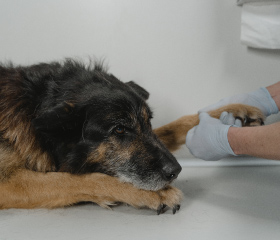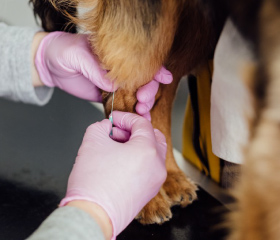Here is a brief list on the most common pet emergencies we see. Phone the vet for advice on what first aid can be given. Take care with painful pets as they may bite, using a thick blanket is helpful for handling painful pets.
- Trauma: road traffic accidents and bite wounds
- Severe vomiting and diarrhoea
- Difficulty breathing (dyspnoea)
- Poisonings and envenomation
- Seizures
- Urination problems


Trauma
TRAUMA should never be underestimated; small bite wounds are ‘icebergs’ with a large amount of tissue trauma that is not visible. Pets can quickly go into shock, necessitating intensive treatment. All cases of a road traffic accident or dog attack require a veterinary consult; minor cases can be postponed until opening hours, but a consult is recommended even if the pet appears unaffected to assess the tissue damage and to start prompt treatment. Trauma to an animal’s eyes always require immediate action. If your pet has been in an accident or been bitten you can cover the wounds with a towel and apply mild pressure. Keep your pet calm, offer a small amount of water.
Vomiting and diarrhoea
VOMITING AND DIARRHOEA are commonly seen in pets; and most recover without much ado, but when is it an emergency? If the vomiting and diarrhoea is severe and protracted for more than 24hours in a normally healthy dog it is an emergency, this time period is shorter if the pet is a juvenile (under 6 months), geriatric (over 10 years), has other health problems (e.g. Diabetes, Addison’s) or further symptoms (high volumes of bloody stool, collapse etc.). If in doubt, phone your vet for advice. Treatment for routine vomiting and diarrhoea is supportive (oral fluids, probiotic paste, bland diet) and should result in recovery in 3 days. Treatment for severe vomiting and diarrhoea usually depends on the results of further diagnostics (x-ray, blood tests, abdominal ultrasound) and often requires hospitalisation.
Difficulty breathing (dyspnoea)
DIFFICULTY BREATHING (DYSPNOEA) is an emergency. There are many things that can cause sudden difficulty in breathing: Heatstroke, heart problems, severe anaemia, pneumonia etc. A good history, examination and diagnostic tests are paramount to determining the cause and necessary treatment. Keeping the pet calm and cool helps to lessen the oxygen requirement pending a vet exam. The vet will place the pet on oxygen until or while further tests like x-rays, ultrasound or blood tests are done to determine the cause.
Poisonings and envenomation
POISONINGS AND ENVENOMATION: A pet is poisoned by ingesting a toxic/poisonous substance (e.g. 2-step or antifreeze in dogs, lilies in cats). A bee sting or snake bite result in envenomation. One or two bee stings do not normally result in danger to pets, but an attack by a swarm is life-threatening. In snake bite cases it is extremely helpful if the snake can be identified (take a photo or bring the dead snake in). In all cases of poisonings and envenomation a timeline can be very helpful when it comes to treatment (e.g. it is not helpful inducing vomiting if the poison was ingested hours ago, if a pet is bitten by a snake but remains asymptomatic it may not be necessary for antivenom depending on the time frame). As in most things, prevention is better than cure: see our list of things poisonous to pets that should be avoided (separate article), and keep your yard clear of garden debris and rodents (both are attractive to snakes).




Seizures
SEIZURES are terrible for a pet parent to witness, but there are two key points that are extremely helpful.
1) TIME the seizure. A seizure may seem to go on forever but is often only a few seconds to a few minutes. If a seizure is going on longer than 5minutes then it warrants emergency veterinary attention. A seizure may have a “pre” and “post” ictal phase; where the dog may seem disorientated, salivate or seem restless.
2) Avoid getting bitten, it is extremely uncommon for a pet to choke on their tongue during a seizure, but many people try reaching into their mouths to grasp the tongue…this is a no-no. Do ensure the pet is somewhere safe where no harm can be done (on a floor, and away from objects).
When do seizures need emergency treatment?
- If a seizure lasts longer than 5 minutes.
- If the pet is having cluster seizures (multiple seizures in a short period of time)
- If the pet is severely affected after the seizures.
We generally advise a veterinary consultation in all cases of suspected seizures; as there are other conditions that can be confused with true seizures.
Urination problems
DIFFICULTY URINATING can be hard to spot in an outdoors pet, but it is an emergency if the pet is not able to urinate. We most commonly see urinary obstructions in male cats; usually due to a plug of inflammatory debris or a spasm. Urinary obstruction can quickly become life-threatening. What to look for: inappetence, pain, vocalising, restlessness, stiff hind legs, frequently trying to urinate, distended abdomen. If you see these symptoms take your cat to the vet immediately. Most cases require an anaesthetic to allow for the obstruction to be displaced, and hospitalisation with fluid therapy.
Always contact your vet before giving your pet ANY medication in an emergency. This will ensure that your pet receives the correct medication at the correct dose. Always let your vet know if you have given your pet medication before bringing it in to the practice.




